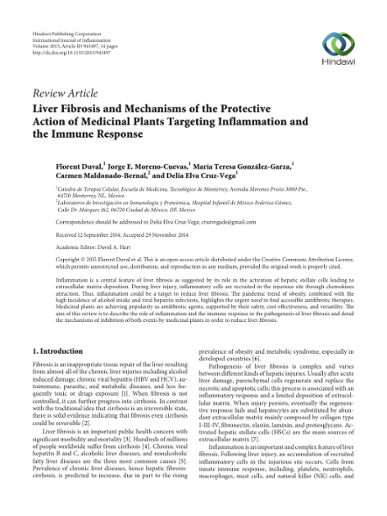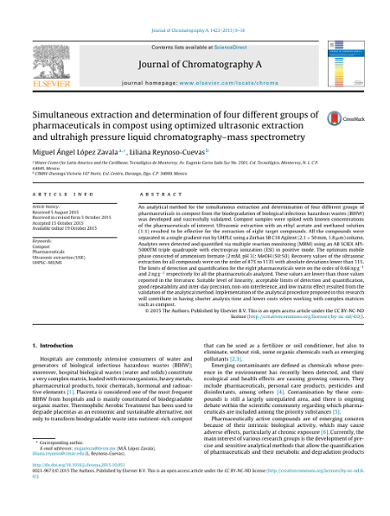| dc.creator | María Teresa González Garza y Barrón | |
| dc.creator | Jorge Eugenio Moreno Cuevas | |
| dc.date | 2015 | |
| dc.date.accessioned | 2018-10-18T20:34:51Z | |
| dc.date.available | 2018-10-18T20:34:51Z | |
| dc.identifier.issn | 20908040 | |
| dc.identifier.doi | 10.1155/2015/943497 | |
| dc.identifier.uri | http://hdl.handle.net/11285/630375 | |
| dc.description | Inflammation is a central feature of liver fibrosis as suggested by its role in the activation of hepatic stellate cells leading to extracellular matrix deposition. During liver injury, inflammatory cells are recruited in the injurious site through chemokines attraction. Thus, inflammation could be a target to reduce liver fibrosis. The pandemic trend of obesity, combined with the high incidence of alcohol intake and viral hepatitis infections, highlights the urgent need to find accessible antifibrotic therapies. Medicinal plants are achieving popularity as antifibrotic agents, supported by their safety, cost-effectiveness, and versatility. The aim of this review is to describe the role of inflammation and the immune response in the pathogenesis of liver fibrosis and detail the mechanisms of inhibition of both events by medicinal plants in order to reduce liver fibrosis. Copyright © 2015 Florent Duval et al. | |
| dc.language | eng | |
| dc.publisher | Hindawi Limited | |
| dc.relation | https://www.scopus.com/inward/record.uri?eid=2-s2.0-84928036904&doi=10.1155%2f2015%2f943497&partnerID=40&md5=71e5eb3938a4797d154533d52a4860cc | |
| dc.relation | Investigadores | |
| dc.relation | Estudiantes | |
| dc.rights | info:eu-repo/semantics/openAccess | |
| dc.rights.uri | http://creativecommons.org/licenses/by-nc-nd/4.0 | |
| dc.source | International Journal of Inflammation | |
| dc.subject | andrographolide | |
| dc.subject | antifibrotic agent | |
| dc.subject | antiinflammatory agent | |
| dc.subject | baicalin | |
| dc.subject | berberine | |
| dc.subject | caffeine | |
| dc.subject | chemokine | |
| dc.subject | chlorogenic acid | |
| dc.subject | curcumin | |
| dc.subject | cytokine | |
| dc.subject | Emblica officinalis extract | |
| dc.subject | Ginkgo biloba extract | |
| dc.subject | ginsenoside Rd | |
| dc.subject | ginsenoside Rg 1 | |
| dc.subject | ginsenoside Rg 3 | |
| dc.subject | glycyrrhizic acid | |
| dc.subject | herbaceous agent | |
| dc.subject | immunoglobulin enhancer binding protein | |
| dc.subject | kutkin | |
| dc.subject | nicotinic acid | |
| dc.subject | Phyllanthus amarus extract | |
| dc.subject | Phyllanthus rheedi extract | |
| dc.subject | Phyllanthus urinaria koreanis extract | |
| dc.subject | plant extract | |
| dc.subject | pyrazinoic acid | |
| dc.subject | salvianolic acid A | |
| dc.subject | silymarin | |
| dc.subject | sodium tanshinone IIA | |
| dc.subject | tanshinone IIA | |
| dc.subject | unclassified drug | |
| dc.subject | unindexed drug | |
| dc.subject | Andrographis paniculata | |
| dc.subject | antiinflammatory activity | |
| dc.subject | Article | |
| dc.subject | Berberis aristata | |
| dc.subject | Bupleurum | |
| dc.subject | Bupleurum falcatum | |
| dc.subject | CD4+ T lymphocyte | |
| dc.subject | CD8+ T lymphocyte | |
| dc.subject | coffee | |
| dc.subject | Curcuma longa | |
| dc.subject | drug mechanism | |
| dc.subject | drug targeting | |
| dc.subject | Ginkgo biloba | |
| dc.subject | ginseng | |
| dc.subject | Glycyrrhiza glabra | |
| dc.subject | human | |
| dc.subject | immune response | |
| dc.subject | inflammation | |
| dc.subject | liver fibrosis | |
| dc.subject | liver protection | |
| dc.subject | macrophage | |
| dc.subject | mast cell | |
| dc.subject | medicinal plant | |
| dc.subject | natural killer cell | |
| dc.subject | neutrophil | |
| dc.subject | nonhuman | |
| dc.subject | pathogenesis | |
| dc.subject | Phyllanthus | |
| dc.subject | Picrorhiza kurroa | |
| dc.subject | priority journal | |
| dc.subject | Salvia miltiorrhiza | |
| dc.subject | Scutellaria baicalensis | |
| dc.subject | Silybum marianum | |
| dc.subject | stellate cell | |
| dc.subject | thrombocyte | |
| dc.subject.classification | 7 INGENIERÍA Y TECNOLOGÍA | |
| dc.title | Liver fibrosis and mechanisms of the protective action of medicinal plants targeting inflammation and the immune response | |
| dc.type | Artículo | |
| dc.identifier.volume | 2015 | |
| refterms.dateFOA | 2018-10-18T20:34:51Z | |


